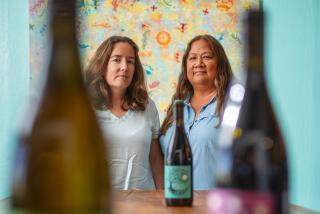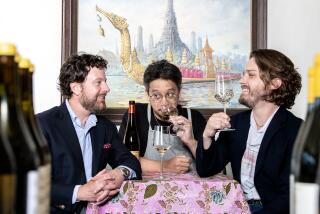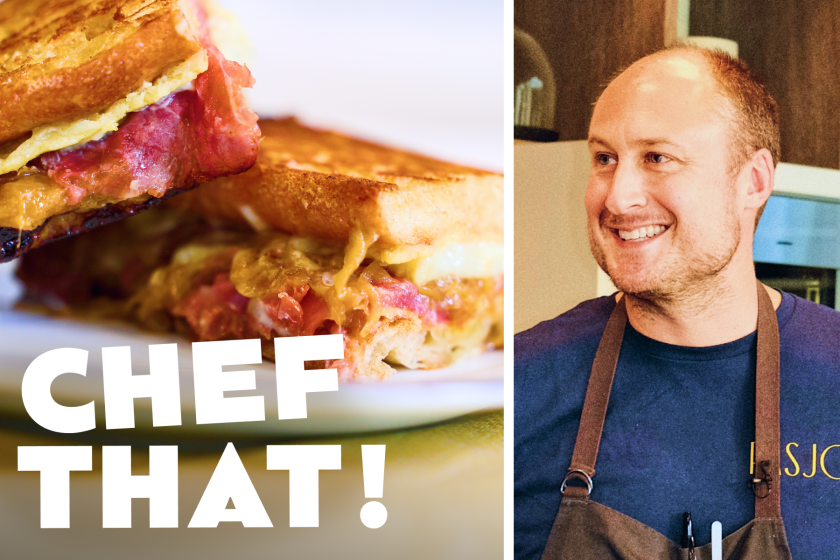5th Wine Symposium Judges 30 Merlots : American Varietal Wine Stands Chance of Becoming a Usefull Everyday Red
Mauiâs Kapalua Bay Hotelâs fifth annual Wine Symposium offered an unusual wine judging recently. For the first time, 30 Merlots were evaluated on a varietal basis as a potential alternative to Cabernet Sauvignon. Heretofore, Merlot, a claret grape, has been used as a Cabernet blending agent to give it a touch of class.
Eric Hansen, chairman of the symposium, gathered a knowledgeable group of tasters, composed of Robert Mondavi; David Lake, English master of wine and enologist at Columbia Winery in Washington; Rodney Strong, Piper-Sonoma; Greg Upton, Franciscan Vineyards; John Wright, Domaine Chandon; Bernard Portet, Clos du Val; Frank Woods, Clos du Bois; Jeremiah Tower, Stars Restaurant in San Francisco, and Robert L. Balzer, a Los Angeles Times Magazine wine columnist.
Despite all the California-honed palates, the panel awarded first place to Washingtonâs Hogue Cellars for Merlot, Reserve 1983. Established in 1982, Hogue is a boutique winery in Prosser, Wash. Although its production is small, it is likely to be heard from again as it develops its 280-vineyard.
Merlots Make the Grade
Actually it is not surprising that a Washington Merlot performed well. Whereas Cabernets there are reaching for California quality, Merlots apparently have made the grade. Several have attracted national attention and awards, thus convincing Washington enologists that the grape and the region are made for each other. The Hogue is a big, concentrated wine that is developing well with a peppery spiced nose. There is some wood showing, with considerable tannin and high alcohol; itâs much like a big Cabernet Sauvignon.
In general, that seems to be the problem with American Merlot as more and more are styled with the bigness, structure and character of long-to-age Cabernets. Initially, the goal of domestic Merlot was much like that of its counterparts in such Bordeaux districts as the Medoc, St. Emilion and Pomerol. There it functions primarily as an elegant softening tool for stylizing hard, robust Cabernets.
As an American varietal wine, Merlot stands a chance of becoming a useful everyday red, provided that its character is pointed toward supple silky softness and early drinkability. Wines that placed well in the judging and qualified for that mode are Markham, 1983, and Mill Creek (Dry Creek Valley), 1983. Mill Creek, with limited fragrance, exhibited generous flavors in a sweet, delicious, appealing style. Markham, also soft and with even greater generosity and roundness, could stand with a bit of age but is most attractive now.
Gundlach Bundschu, Sonoma, Merlot, 1983, displayed lovely, sweet fragrance, a dark color and deep density but with the ever-present soft Merlot flavors. This is a voluptuous wine, generous to the point of extremely easy access and a pleasantly drinkable style.
Delicious Supple Mode
Another Merlot in a delicious supple mode and demonstrating what Merlot ought to be in terms of overall style is Geyser Peak, Alexander Valley, 1983. Not as big as the Hogue, it should age for a couple of years, but its flavor length and depth with ample soft tannins makes the wine a winner and quite appealing for todayâs consumption.
Clos du Val, 1983, reflected more of a Cabernet style, larger in structure yet greater in length and depth. An obviously good candidate for aging with higher alcohol and density, its richness will surely develop well over the next several years. Newton Merlot, 1982, rated well because of excellent developing fragrance and a good middle palate, whereas Inglenook, Estate Bottled, 1983, provided good, soft flavors and multiple layers of texture, representing a Cabernet-like style that will mature nicely. In a similar big mode is Jaeger Inglewood, 1981.
Placing high in the judgesâ ranking was Robert Keenan, 1983, with still-locked-in fragrance and flavor representing more of a Cabernet style and requiring long-term aging. Sterling, 1983, featured an appealing cherrylike taste obviously fashioned for later drinking. Sonoma Vineyards, 1984, showed sweetish fragrance, good flavors, a bit of wood and a big Cabernet style with high tannin and alcohol.
A wine that caught my fancy was Charles Krug, 1982, which provided lovely sweetish fragrance and soft appealing flavors in length and depth. It is a fine Merlot with an ability to age for several years. Boeger, El Dorado, 1983, also needs time to refine its silky goodness of fine fruit and lush flavor. Clos du Bois, with a high rating from the panel, displayed an excellent soft, developing style that can be enjoyed now for its long, flavorful finish.
Personal Favorite
Another personal favorite was Stratford, 1983, in a big Cabernet style, but apparently softening with svelte texture and good, in-depth flavor. Louis Martini, 1982, by contrast is lighter in structure and style, obviously intended for todayâs drinking. Other choices, in descending order of preference, were Franciscan, 1983; Chateau St. Michelle, Washington State, 1982; Pine Ridge, Second Cuvee, 1983; Robert Young, Alexander Valley, 1983; St. Francis, Sonoma, 1982, and Columbia, Washington State, 1983.
All of the tasters had different concepts as to what Merlot should be, but they universally agreed that Merlot suggested two aroma and flavor styles. One is an herbal vegetal nose and taste, whereas the other reflects a black currant, cassis mode similar to that found in Pomerol. The herbal smells and tastes were of a dill-weed mode.
Fashioning Merlot strictly as a single varietal is still a new enologic plaything. At Clos du Val, for instance, it has been offered as a varietal only since 1977. Portet, the wine maker at Clos du Val, strives for softness, fullness and roundness but also sees an opportunity for complex development along Cabernet lines.
Upton, wine maker at Franciscan, defines the wine in California terms as one which displays stately feminine charms, delicacy of flavor and a cherry fruitiness not unlike Cabernet. He prefers those with a bit of Cabernet flesh and, therefore, adds about 10% Cabernet Sauvignon to his blend.
Mondavi, in fashioning the expensive Opus One wine, uses only 5% Merlot, but he said that he is considering more in order to provide greater leanness and earlier drinkability. Interestingly, Jean Delmas made his famous first-growth Chateau Haut Brion utilizing one-third Merlot. Against the trend, the Merlot has been eliminated in favor of Petit Verdot and Malbec.
Storm of Controversy
As more Merlot is produced, a storm of controversy will develop as it becomes a greater varietal fixture. French producers in particular, except for a few notable Pomerol exceptions, bemoan the use of Merlot as a single varietal wine. Philippe Cottin, general manager of Chateau Mouton Rothschild at Pauillac, does not think of Merlot as a wine of stately feminine charm, but rather as a varietal with street-wise charms that are visible up front and with no depth. That is not an uncommon view in California, too.
Most of the symposium panel members disagreed. Frank Woods of Clos du Bois articulated the majority view: âAt our winery it is becoming our most important red and we see it as strongly expanding in the marketplace. What we like about it best is that you donât need to be as sophisticated to drink it as, say, for Cabernet because of its soft tannin approach. (The Merlotâs) taste vanishes in the back of the mouth as if gently gliding by without as strong a taste statement as Cabernet.â
Strong of Piper-Sonoma offered the final word. âMerlot is a new classic breathless grape; or is it a question of cycles of taste? We get bored easily with this yearâs darling varietal, which may be next yearâs bore. Iâm convinced Merlot is here to stay and will become classic red.â The symposiumâs long-overdue Merlot focus confirmed his view.
More to Read
Eat your way across L.A.
Get our weekly Tasting Notes newsletter for reviews, news and more.
You may occasionally receive promotional content from the Los Angeles Times.










